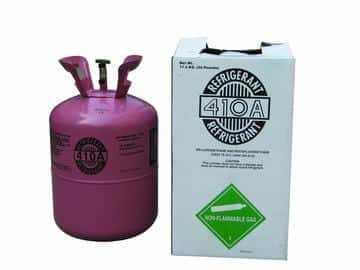What Should I Do When The HVAC Freon is Low in My Air Conditioner?
Updated Summer 2023
Freon (R22) has been phased out of being manufactured since 2010, and finally banned in 2020. Air Conditioning Systems are still functioning with the same principles of heat transfer, but now use primarily R410a refrigerant (in residential HVAC systems) While the freon reference in this post is dated, the process is still valid and valuable for homeowners researching low refrigerant in their A/C.
As we eventually get into spring and summer, and air conditioners across Indiana again get fired up we will get hundreds of phone calls from customers whose A/C’s won’t keep up. A very common diagnosis for air conditioners that can’t keep up is low refrigeration. Before you give the go-ahead to your HVAC company to “charge” the system, which is the term used to refill to the appropriate level, there are a few things you need to know about HVAC Freon.

1) Know what kind of refrigerant your air conditioner or heat pump uses and how low it is
R22 which is commonly known as freon was the most prominent refrigerant in use until a few years ago when the EPA mandated production be stopped. In it’s place R410a (Puron) refrigerant has taken over as the primary refrigeration used. Once you know the type, the HVAC professional should be able to give at least a range of estimate on how the system is on refrigerant.
2) Why is my HVAC Freon refrigerant low?
Air conditioners and heat pumps are closed loops systems. Unlike gas in your car, refrigeration doesn’t just disappear over time. If your system is low causing a lack of cooling, there is likely a leak in the system.
3) Should I leak test or not?
Knowing that your system has a leak, there are two ways to go about repairing. If you’ve never had the refrigerant recharged on your system, you can do so without a leak test. Depending on the age and condition of your air conditioning, your system might have a slow leak which may be able to hold the new refrigerant. However, if you’ve already had refrigerant added in the past or are concerned that the leak is more significant, a leak test is required before adding any additional refrigerant.
4) What kind of leak test will be done?
Everyone has their opinion on which leak test is the best, but many times the technician on site will offer up an opinion on which he thinks will identify your issue in the most cost effective way. There are devices that detect refrigerant that is out of the system, that a technician can run along joints and coils of the A/C system. We can evacuation the system and put it under high pressure nitrogen test, where the joints, coils and other problem areas are coated in soap bubbles to detect air leakage. There are additional tests outlined by the EPA here, which meet their high standards. The bottom line is that your HVAC professional should detail the type of test and cost before proceeding.
5) Where’s the HVAC Freon leak and how much is the repair?
Depending on what the leak test shows there are really two distinct directions. It is likely an easy fix in a visible joint or valve that can quickly be repaired, or it’s something more significant in the evaporator or condenser coil. The former because of the limited expense is an easy go-ahead if it’s an R410a system. If you are dealing with a coil and an R22 system, you should probably discuss replacement of the full system because of the significant expense of both the equipment and refrigerant.
Need Your Freon Levels Checked or A/C Replaced?